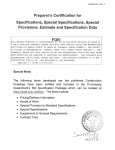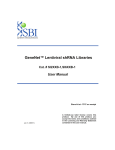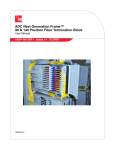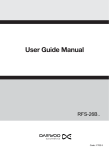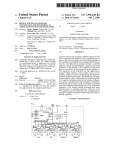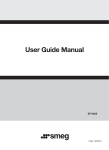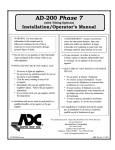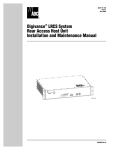Download SECTION 9--CROSS-CONNECT SYSTEMS
Transcript
DETAIL ENGINEERING REQUIREMENTS AT&T Section 9, ATT-TP-76400 January, 2012 SECTION 9 -- CROSS-CONNECT SYSTEMS CONTENTS 1. PAGE GENERAL .............................................................................................................................. 9-2 1.1. 2. Introduction ...................................................................................................................... 9-2 DISTRIBUTING FRAMES (DF) ............................................................................................. 9-2 2.1. 2.2. 2.3. 3. General ............................................................................................................................ 9-2 Zoning and Spread Complete ......................................................................................... 9-3 Distributing Frame Functions........................................................................................... 9-3 DISTRIBUTING FRAME TYPES ........................................................................................... 9-4 3.1. 3.2. 3.3. 4. Protector Frames ............................................................................................................. 9-4 Modular Distributing Frames ........................................................................................... 9-4 Conventional Distributing Frames ................................................................................... 9-5 FRAME BLOCKS ................................................................................................................... 9-6 4.1. 4.2. 4.3. 4.4. 5. General ............................................................................................................................ 9-6 Connector/Connecting Blocks ......................................................................................... 9-6 Protected Connectors ...................................................................................................... 9-6 Distributing Frame References ........................................................................................ 9-7 MANUAL DIGITAL SIGNAL CROSS-CONNECT (DSX) ....................................................... 9-7 5.1 5.2 5.3 5.4 5.5 5.6 5.7 6. General ............................................................................................................................ 9-7 DSX-1 Considerations ..................................................................................................... 9-8 Interbay Patch Panels ..................................................................................................... 9-8 Cross-Aisle Tie Pair Panels & Bridges ............................................................................ 9-8 DSX-1 Cross-Connect Rules ........................................................................................... 9-9 DSX-3 Considerations ................................................................................................... 9-10 DSX Cross-Connect References ................................................................................... 9-13 FIBER DISTRIBUTING FRAMES (FDF).............................................................................. 9-13 6.1. 6.2. 6.3. 6.4. 6.5. 6.6. 6.7. 6.8. 7 General .......................................................................................................................... 9-13 Satellite Fiber Distributing Frame .................................................................................. 9-15 FDF Applicability............................................................................................................ 9-15 The FDF......................................................................................................................... 9-16 Fiber Splitters ................................................................................................................ 9-18 Optical Terminations and Connectors ........................................................................... 9-18 Attenuators .................................................................................................................... 9-19 FDF References ............................................................................................................ 9-19 ETHERNET DISTRIBUTING FRAMES (EDF) .................................................................... 9-19 7.1 7.2 7.3 7.4 7.5 General .......................................................................................................................... 9-19 Electrical Ethernet Distributing Frames ......................................................................... 9-20 Electrical EDF Components for the C.O........................................................................ 9-21 Cable Requirements ...................................................................................................... 9-21 References .................................................................................................................... 9-21 9-1 Section 9, ATT-TP-76400 DETAIL ENGINEERING REQUIREMENTS January, 2012 AT&T Table 9-1 – summary of changes in section 9 Revision Date Item Action Requirements Change Notification 3/26/2014 6.3.1 Modification ATT-TP-76400-103 4/1/2014 6.4.1 Modification ATT-TP-76400-104 4/9/2014 6.4.13 Add ATT-TP-76400-105 4/18/2014 7.1.4 Add ATT-TP-76400-106 5/15/2014 6.4.13 Modification ATT-TP-76400-107 5/16/2014 7.1.4 Modification ATT-TP-76400-109 10/2/2014 6.4.14 Add ATT-TP-76400-125 1/19/2015 6.1.19 Modification ATT-TP-76400-132 1. GENERAL 1.1. Introduction 1.1.1 The cross-connect network is comprised of conventional Distributing Frames (DF), modular DF, manual Digital Cross-connect (DSX1 and DSX3) frames, Fiber Distributing Frames (FDF), and Ethernet Distributing Frames (EDF). 1.1.2 Changes in this issue of Section 9 are summarized in Table 9-1. 1.1.3 Providing optimum flexibility and economy in the network is the objective of cross-connect engineering. Successful engineering of the network components requires efficient work operations, while avoiding blocked line-ups, premature jumper trough congestion, lack of equipment spread, and tie cable overuse. 2. DISTRIBUTING FRAMES (DF) 2.1. General 2.1.1 Distributing frames (DF’s) are manually operated, cross-connection devices used for the efficient connection between Carrier Communications Space equipment and outside plant cable facilities. 2.1.2 The Distributing Frame supports the interconnection needs for customers, carriers, other telecommunications providers (CLEC’s), switches, transport equipment, and cable facilities within the serving Wire Center (WC) area. 2.1.3 Distributing frames fall into two functional configurations: Main Distributing Frames (MDF) and Intermediate Distributing Frames (IDF). MDF's and IDF's are available in two physical 9-2 DETAIL ENGINEERING REQUIREMENTS AT&T Section 9, ATT-TP-76400 January, 2012 forms: conventional distributing frames and Universal Modular distributing frames. More detailed descriptions of frame types can be found in section 3 of this document. 2.1.4 In most instances the DF equipment to be installed will be purchased new from an approved manufacturer. However, in some cases the equipment may be supplied to the Installation Vendor through the AT&T reuse program or by way of a direct transfer from one Carrier Communications Space to another. When used equipment is supplied by the Installation Vendor from another source, it shall be accompanied by a 10 year warranty provided by the Installation Vendor. This written warranty shall provide coverage for both cosmetic and structural defects. The Installation Vendor will be held responsible for all costs associated with the repair or replacement of the equipment during the 10 year warranty period. Additionally, used equipment furnished by an Installation Vendor shall have the word “Salvaged” and the warranty expiration date, (10 years from the installation date) added to the standard labeling. 2.2. Zoning and Spread Complete 2.2.1 All MDF’s shall be zoned. Zoning refers to the practice of logically dividing the frame, where practical, into multiple vertical sections, or zones. The vertical and horizontal sides of an MDF are zoned independently of each other. Zoning is utilized to exploit the short jumper concept, in which an assignment algorithm is used to ensure the shortest possible jumper lengths. 2.2.2 Spreading is defined as the placement of related equipment in several locations on the frame, e.g. rather than placing all OE in a concentrated location on the DF, it is spread across the frame. This is done in conjunction with the corresponding spread of OSP terminations on the vertical side of the frame. This keeps the jumper wires that are run on the frame shorter, the frame less congested, and prevents premature exhaustion of the frame hardwire. 2.3. Distributing Frame Functions 2.3.1 Main and Intermediate Distributing Frames. The primary copper facility frame is known as the Main Distributing Frame (MDF). The MDF is the frame that has the standard terminations of the local indigenous switch OE/LEN facilities, cable pairs to the customers and tie pairs to other frames and equipment. 2.3.2 In multiple conventional frame central offices, it is recommended that transport and CLEC terminations be placed on the IDF unless the MDF has sufficient space to support these terminations and still allow for ILEC growth. Transport and CLEC terminations shall not be placed on a COSMIC MDF. 2.3.3 Transport, CLEC and other miscellaneous terminations, located on the Intermediate Distributing Frame (IDF) shall be connected via Inter-Frame Tie cables to the MDF. 2.3.4 Existing MDF’s may be either conventional or modular. If the MDF is modular, a conventional IDF is required and shall be placed to support it. 2.3.5 The primary functions of distributing frames are: • Termination of Facilities/Equipment. 9-3 Section 9, ATT-TP-76400 AT&T • Equipment cross-connect point. • Electrical Protection. • Test and Cable Access DETAIL ENGINEERING REQUIREMENTS January, 2012 3. DISTRIBUTING FRAME TYPES 3.1. Protector Frames 3.1.1 Protector frames (PF) may be either conventional or modular. 3.1.2 Protector frames are provided for the protection and termination of outside plant copper cable pairs. These frames have no provisions for cross-connections, and are used in conjunction with separate distributing frames. Outside plant cable pairs are terminated on protector blocks on the PF. A cable is then placed from the protector block on the PF to a corresponding terminal block on the MDF. The outside plant cable pairs on the MDF can then be cross-connected to Carrier Communications Space equipment terminations elsewhere on the MDF. The use of separate Protector Frames (PF’s) generally facilitate higher density MDF configurations since more connector blocks can be mounted on the MDF than protector blocks. 3.1.3 A protector frame only provides termination and protection capabilities for outside plant cable pairs. 3.2. Modular Distributing Frames 3.2.1 Modular distributing frames currently in service include the below listed products. The existing product may be grown to the completion of the next zone or end of lineup. 3.2.2 9-4 • Lucent Technologies ESS Modular Distributing Frame (Non-Standard Manufacturer Discontinued) • COSMIC I - Common Systems Main Inter-Connecting Frame with separate Protector Frame (Non-Standard - Restricted Use, growth only) • COSMIC II -Common Systems Main Inter-Connecting Frame with integrated Protector Frame (Non-Standard – Restricted Use, growth only) • CODS – Carrier Communications Space Distribution System, Emerson Network Power (Non-Standard) • PORTA Systems - CAM DF (Non-Standard) • Reltec Systems – COS II (Non-Standard) • Robotic Frame – ADF (Non-Standard, growth only) Growth to existing Modular Distributing Frames shall be the CommScope COSMIC I or II for all modular installations and applications, subject to the limitations noted in ATT-002-216025, Switching IDG, Tab 11, and ATT-PAN-20011072, Restricted Use PAN for Avaya COSMIC Frames (Now CommScope). DETAIL ENGINEERING REQUIREMENTS AT&T Section 9, ATT-TP-76400 January, 2012 3.2.3 The modular distributing frames are a sheet metal structure designed for single-sided crossconnect operation. This means that all terminations from both subscriber facilities and from office equipment are accessible for cross connection from one side. Outside plant cable pairs (CP) and line equipment (LE) pairs are normally terminated in alternating modules. The modular framework groups consist of vertical jumper troughs between modules and express wiring troughs at the top and bottom of each module. With the proper spread of cables and equipment, the jumpers need be no longer than from one module to the next module. They can be engineered with or without separate protector frames for most applications. 3.2.4 Modular distributing frames use the preferential assignment concept. Computerized frame administration systems are used to spread the outside plant cables and equipment cables over the length of the frame. Facilities and equipment are selected based on physical proximity on the DF. The resulting short jumpers reduce congestion and improve network operations efficiency. AT&T uses FrameMate as a mechanized DF administration system for this purpose. 3.3. Conventional Distributing Frames 3.3.1 Conventional distributing frames are characterized by open ironwork construction with vertical apparatus mounting frame members on one side and horizontal members on the opposite side. Most conventional frames are designed for double-sided cross-connection operations; however, some single-sided versions are available. Adapters used to mount different types of apparatus on frames are identified on manufacturer’s frame hardware drawings. Virtually all conventional frames can be arranged for application with or without separate protector frames. 3.3.2 Conventional distributing frames, unlike protector frames, have cross-connecting features including shelves and “D” rings to route jumper wire and connecting apparatus specifically designed for frequent jumper connections and disconnects. 3.3.3 There are many variations in conventional frame heights, widths, and hardware-mounting dimensions to accommodate specific applications and Carrier Communications Space building sizes. The standard for new installations shall be the 8’ 10” high double-sided DF system. 3.3.4 Copper cable pairs and derived pair gain terminations on conventional frames are mounted on vertical uprights. Transport/Switch and other miscellaneous termination units are mounted on horizontal levels. 3.3.5 Verticals shall be spaced on 8-inch centers unless otherwise specified by the AT&T Equipment Engineer. Some special application frames have 6 1/2-inch vertical spacing. 3.3.6 Horizontals shall be spaced on 8-inch centers. Older frames may have 10-inch spacing. Current standards call for 8 inch centers for both verticals and horizontals. 3.3.7 Verticals shall be numbered consecutively (usually from the non-growth end to the growth end) starting with number 1. The first vertical is ordinarily not furnished with jumper rings and is not used for terminating facility cable pairs. 3.3.8 The first vertical of a frame is usually reserved for plug-up and test line protectors. 9-5 Section 9, ATT-TP-76400 AT&T 3.3.9 DETAIL ENGINEERING REQUIREMENTS January, 2012 Horizontal levels shall be identified by letter designations starting with the letter A at the bottom, omitting letters I and O. Individual blocks/terminal strips on the horizontal level shall be identified by the associated vertical number. Designation instructions shall be provided to the installer via the engineering spec. 3.3.10 Designations shall be provided at various points to identify the vertical number on both sides of the conventional frame. See Section L of ATT-TP-76300 for details. Designation instructions shall be provided to the installer via the engineering spec. 4. FRAME BLOCKS 4.1. General 4.1.1 Frame blocks fall into two general categories – Connector or Connecting Blocks and Protector Blocks. The connector block provides no electrical protection functions. Protector blocks provide electrical protection for OSP cable facilities that are terminated on the MDF. 4.1.2 Frame assignments shall be provided by the authorized AT&T Engineer, commonly the Frame Planner/CSSP (Common Systems Space Planner), however, local policy shall dictate the appropriate authorized engineer. 4.1.3 The authorized individual (generally the CSSP/Frame Planner), will be specified by the AT&T Equipment Engineer in the TEO. 4.1.4 All blocks on the frames shall have wire wrap terminations, unless the embedded base of existing blocks on the frame is made up of Quick-Clip/punch down, type blocks. In that case the quick clip blocks will be allowed. 4.1.5 Bifurcated (read dual) pins are required for connecting blocks used for line equipment and CLEC CFA terminations. This facilitates half taps for cutovers, cable throws and “from/to” service orders. 4.1.6 Only AT&T approved frame blocks shall be used per drawing ATT-E-00087-E Note 11. 4.1.7 No variances from 4.1.6 shall be allowed. 4.2. Connector/Connecting Blocks 4.2.1 The standard connecting block for conventional frames is the non-connectorized 89-type block. 4.2.2 The standard connecting blocks for modular distributing frames are: • COSMIC I and IA - 78 or 112 type connecting block are the common units. • COSMIC II, IIA and II mini - 112 type connecting block is the common unit • Existing Reltec or Porta Frames may continue to use their respective proprietary blocks for frame continuity and consistency. (Shall require OTA.) 4.2.3 The 78 and 112 type connector block shall not be mixed on the same COSMIC DF. 4.3. Protected Connectors 9-6 DETAIL ENGINEERING REQUIREMENTS AT&T Section 9, ATT-TP-76400 January, 2012 4.3.1 Protected connector blocks provide access, electrical protection, unit sockets and testing appearances for OSP cable pairs and trunk cable pairs. 4.3.2 Low density connectors are approved as alternative connectors for use in offices that have an existing installed base of 302 or 303 type connectors. This use of the low density connectors shall be limited to filling a vertical that is partially equipped with the same connectors. 4.3.3 Empty verticals shall use the higher density connectors. 4.3.4 The new connectors shall be wire wrap models and equipped with 5 pin protector sockets. The connector type will be specified by the AT&T Equipment Engineer. 4.3.5 The plug-in protector units are not included with the various connector blocks and shall be ordered separately. The new purchase shall be the 4C Gas Tube Type Protector except in the Southeast region where Solid State protectors shall be provided for general use and Gas Tube for Lightspeed applications. Several colors of protector are available: • Black: POTS/Voice Grade Services • Red: Special Circuit 4.3.6 Several markers and protector covers have been standardized for further identifications. The AT&T Equipment Engineer should be contacted for information on these items. 4.3.7 All outside plant pairs entering a Carrier Communications Space shall have protection at the protector blocks since there is the potential for High Voltage applications to be present. These protectors safeguard personnel, equipment, and the network from hazards such as electrical shock, equipment damage, and fire caused by lightning and AC power faults. 4.3.8 Coil Test devices shall be provided for pre-testing of protectors before use. 4.4. Distributing Frame References ATT-TELCO-000-000-020 Acronyms and Abbreviations Dictionary ATT-TELCO-002-316-003, Frame Forecast M&P ATT-TELCO-812-000-012 Distributing Frame Standards Telcordia Practice BR 781-822-005 BSP 201-219-101, Protector Frames-General BSP 201-222-050, COSMIC DSS System-General 5. MANUAL DIGITAL SIGNAL CROSS-CONNECT (DSX) 5.1 General 5.1.1 A DSX frame provides a manual method of cross connecting DS1, DS1C, DS3 and STS1 services, in addition to Digital Cross Connect Systems (DCS). Examples of services and applications which may terminate on a DSX1/DSX3 are ones such as: “Nail Up” services, Collocation, Synchronous/Asynchronous equipment, and Electrical interconnections. 9-7 Section 9, ATT-TP-76400 AT&T DETAIL ENGINEERING REQUIREMENTS January, 2012 5.1.2 By contrast, the DCS is an electronic and/or optical cross-connect method for the same services. Examples of services and applications which may terminate on the DCS are ones such as: Potential rearrangement customers, Transport traffic, DS3-STS1-DS1-DS0-OC Multiplexing functionality, Software conversions from DS3-STS1 and back, Regeneration of signals, and Network reconfiguration services. 5.1.3 The following fundamental functions performed at a DSX frame are: Termination, CrossConnecting, Testing, Patching and Rolling. 5.2 DSX-1 Considerations 5.2.1 Planning of the DSX1 lineup will dictate careful consideration of the Carrier Communications Space layout. It is important to place the DSX1 lineups (if multiple) in a parallel arrangement with appropriate troughs for adequate jumper placements. 5.2.2 The length of the continuous lineup may be up to 80 feet with the correct provisions. 5.2.3 DSX-1 Rear Cross Connect bays/line-ups shall require rear aisle lighting to meet with the minimum foot candle requirement for Equipment Frame Area Maintenance Aisle standards as described in Table 6-3 of Section 6 in ATT-TP-76400. 5.3 Interbay Patch Panels 5.3.1 Interbay patch, or Beltline, panels, give local personnel the ability to patch/restore circuits without using excessively long cords (short cords to the panels on either end with engineered cable between the panels). 5.3.2 New DSX1 and DSX3 lineups shall have one inter-bay patch panel appearance every five bays. 5.3.3 Unless specifically stated in the TEO for any existing four bay interbay panel configurations, continue to use those same bays for additional interbay panels from new lineups and extensions of existing bays using the five bay formats. When the next new interbay is identified, place it five bays away from the last four bay interbay panels on the end cap. Continue on the existing lineups using the five interbay formats. Connect these to the existing four bay interbay panels interspersed throughout the frame. Any existing pattern other than the one per five arrangements shall be capped. 5.4 Cross-Aisle Tie Pair Panels & Bridges 5.4.1 Cross-aisle tie pair panels are used in DSX1/DSX3 lineups to provide the ability to crossconnect two DS-1 or DS-1C/DS-3 or STS-1 circuits terminated on different DSX1/DSX3 lineups. 5.4.2 The DSX1 cross-aisle tie circuits consist of five wires terminated at each end on the rear of a cross-aisle tie pair panel. Some older DSX1 equipment may use six wire cross-connections, with the sixth wire used to connect the ground leads from the fuse and alarm panels. This insures a consistent ground reference for tracing lamps. 5.4.3 These tie pair panels shall be strategically placed in the same interbay panel bays in both DSX1/DSX3 lineups to avoid tie pair cable congestion and long cross-connect jumpers. 9-8 DETAIL ENGINEERING REQUIREMENTS AT&T Section 9, ATT-TP-76400 January, 2012 5.4.4 New Cross-Aisle Bridges shall be a preferred alternative to Cross-Aisle Tie Pair Panels. 5.5 DSX-1 Cross-Connect Rules 5.5.1 In order to maintain complete flexibility, planning of the office size is of primary importance and determines the ultimate size and layout of the DSX1and should be made according to the following guidelines: A.) Minimize the amount of multiple jumpers. B.) Use both the bottom and top horizontal troughs for jumpers that will traverse over two panels distance. C.) Each Carrier Communications Space shall maintain the consistent standard at which point the jumpers are reversed to connect two T1s. D.) Larger troughs shall be purchased and installed when the jumper depth reaches the top of the trough panel at any point in the lineup. E.) Work all disconnects and remove all jumpers and inter-bay cross-aisle panels and erase the circuit identification on the faceplate of the panels. F.) Provide slack on the horizontal trough of each panel not to exceed 4 inches nor be less than 2 inches. 5.5.2 To alleviate cable congestion in the relay rack duct, a minimum of 5 inches of space shall be provided between each 56 port/panel-bay 5.5.3 To alleviate cable congestion in the relay rack duct, a minimum of 5 inches of space shall be provided between each 84 port/panel-bay. 5.5.4 It is recommended, when troughs are bay supported, to either install a skeleton bay (subject to future availability) to pre-equip the required horizontal troughs or to place a complete set of troughs when each new bay is installed in a lineup. Additional bays in a DSX1 lineup may result in possible cable congestion in the overhead racks. 5.5.5 DSX-1 panels shall be located in 7 foot bays for new deployments. Existing line ups with embedded DSX-1 panels placed above the 7 foot level may be completed to the end of the line up, but all new line ups shall have new deployment of DSX-1 panels located only in 7 foot bays. 5.5.6 Any tie cable panels should be mounted at the top of the DSX-1 bay at the 6-7 foot level. 5.5.7 For new DSX-1 lineups in central offices, bantam type jack panels shall be provided. 5.5.8 All DSX patch panels shall be physically and electrically compatible in the same DSX1 lineup. 5.5.9 An upper and lower express trough shall be provided for each bay. 5.5.10 All hardwired cables between the connecting equipment and the DSX1 (DCS panel) shall be sized according to length as follows. The 22, 24 and 26 gauge cables may be wire wrapped at the switch or network element end; or may be connectorized at the factory. The following 9-9 Section 9, ATT-TP-76400 AT&T DETAIL ENGINEERING REQUIREMENTS January, 2012 length limitation tables from a DSX1 or DCS panel apply to switch elements as well as network elements. A. Length limitation from DSX1 panel to switch element or network element using wire wrap technology: 1.) 26 gauge 407.5 feet (This gauge cable shall be the FIRST CHOICE until the length limitation is exceeded) 2.) 22 gauge 612.5 feet (This gauge cable shall be the SECOND CHOICE after 26 gauge except for cross-aisle applications or when the 26 gauge length limitations are exceeded) 3.) 24 gauge 507.5 feet (This gauge cable is NOT NORMALLY USED as LBO range settings are typically listed for 26 gauge and 22 gauge cables) B. Length limitation from DCS to switch element or network element using wire wrap technology: 1.) 26 gauge 900 feet (This gauge cable shall be the FIRST CHOICE until the length limitation is exceeded) 2.) 22 gauge 1310 feet (This gauge cable shall be the SECOND CHOICE after 26 gauge except for cross-aisle applications or when the 26 gauge length limitations are exceeded) 3.) 24 gauge 1100 feet (This gauge cable is NOT NORMALLY USED as LBO range settings are typically listed for 26 gauge and 22 gauge cables) C. When hardwired DS1 Cable length runs are in excess of the transmission range of 26 gauge cables, use 22 or 24 gauge cable. The above stated Length limitations from DSX-1 panel or DCS to a switch element or to a network element may be adjusted downward/reduced in length to allow for longer DSX-1 Y2, 24 gauge Cross-Connect Lengths, in excess of the stated 85 foot limitation. 5.5.11 Transmit and receive signals shall be in separate cables from the transport equipment to the DSX1 except as manufacturer requirements dictate 5.6 DSX-3 Considerations 5.6.1 All hardwired cables between the connecting equipment and the DSX-3 shall be 75 ohm coaxial cable with a single tinned copper shielded braid. When hardwired cable length runs are in excess of the transmission range of 735C coaxial cable, use 734C coaxial cable. Use of 734C coaxial cable is required in IXC offices unless written approval for use of 735C coaxial cable is obtained from AT&T Standards. Note: 734C is the thicker, longer range, coaxial cable and 735C is the thinner, shorter range, coaxial cable. NOTE: AT&T will not require the Switch Manufacturers (Alcatel-Lucent, Nortel, Siemens and Ericsson), to use 734C/735C cable in place of 734D/735A cable on Switch jobs. However, the Switch Supplier’s coaxial cable stripping tools and coaxial connector crimping tools must meet 9-10 DETAIL ENGINEERING REQUIREMENTS AT&T Section 9, ATT-TP-76400 January, 2012 the approval standards of AT&T Common Systems on all Switch jobs in which 734D and/or 735A cable is to be installed. Furthermore, the Switch Supplier must continue to use only those connectors approved by AT&T on such jobs. 5.6.2 The maximum hardwired cable length between the DSX-3 and connecting equipment is 427.5 feet for 734C coaxial cable. If 735C cable is used, the maximum cable length between the DSX-3 and connecting equipment is 227.5 feet. The standard cross-connect cord (735 type) used between two (2) DSX-3 panels will be limited to 45 feet in length, while the longer-range cross-connect cord (734 type) used between two (2) DSX-3 panels will be limited to 88 feet. The following are length limitations for 735C coaxial cable (from Active Element to Active Element with and without DSX-3 panels.) 1.) From Network Element to DACS using direct cabling between the Network Element and DACS – 500 feet (if intermediate DSX-3 panels are placed within this circuit, the length limitation is reduced from 500 feet to 455 feet) 2.) From DACS to DACS using direct cabling between the two(2) DACS – 500 feet (if intermediate DSX-3 panels are placed within this circuit, the length limitation is reduced from 500 feet to 455 feet) 5.6.3 To alleviate coaxial cable congestion in the relay rack duct, a minimum of 5 inches of space shall be provided between each front cross-connect DSX-3 bay. 5.6.4 To alleviate coaxial cable congestion in the relay rack duct, a minimum of 5 inches of space shall be provided between each rear-rear cross-connect DSX-3 bay. 5.6.5 Vertical rings shall be provided for each bay between the troughs. 5.6.6 Cross-aisle jumper troughs shall be mounted in the rear for rear cross-connect bays and at the front for front cross-connect bays. 5.6.7 Only BNC connectors listed on the approved products list shall be used within AT&T. The following statements apply ONLY to field-formed BNC connectors by contracted installers. The factory-formed connectors can be any/all of the approved BNC connectors: Kings, Trompeter or ADC. Kings, Trompeter or ADC may be used for factoryformed BNC cable assemblies, which typically are shipped out as single-ended cable assemblies, with the other end field-formed according to the statement immediately below: 1.) Kings BNC connectors shall be used in the West, Southwest and East regions and must be crimped with Newhall Pacific/CCI’s tools. 2.) Trompeter BNC connectors shall be used in the Midwest and must be crimped with Trompeter tools. 3.) ADC BNC is the preferred connector to be used in the Southeast and must be crimped with ADC tools. Trompeter BNC may be used in the Southeast and must be crimped with Trompeter tools. 9-11 Section 9, ATT-TP-76400 DETAIL ENGINEERING REQUIREMENTS January, 2012 AT&T 4.) Legacy AT&T shall use the BNC connectors listed in 1.), 2.) and 3.) above within the same regions cited. In all other areas, the existing BNC choice shall be used. Each of these specific brand-name crimp tools will be required to crimp these same brandname connectors and are not interchangeable except when allowed by a specific connector manufacturer. It is important to understand that the tools specifically identified as Newhall Pacific Tools are now available only through Conway Communications and are used ONLY for crimping the center pin and outer hex sleeve of the Kings connectors. Also, the center pin Trompeter Electronics crimp tool must be used ONLY for crimping the center pin of the Trompeter connector. Finally, the center pin ADC crimp tool must be used ONLY for crimping the center pin of the ADC connector. NEVER interchange brand-name tools, otherwise BNC connector failures WILL OCCUR. Legacy SBC - AT&T BNC Regions: (22 States) West: CA, NV Southwest: AR, KS, OK, MO, TX Midwest: IL, IN, MI, OH, WI, Southeast: AL, FL, GA, KY, LA, MS, NC, SC, TN East: CT Legacy AT&T BNC Regions: (50 States) 5.6.8 The hardwired cables from the connecting equipment to the DSX-3, or from the connecting equipment directly cabled to the DCS, shall be provided in one of the following two ways, as authorized by the AT&T Equipment Engineer: A.) One end factory crimped and the OTHER end field crimped, within an AT&T central office, by an AT&T approved Installation Supplier. This is the preferred method. B.) Bulk coaxial cable requiring field crimping, within an AT&T central office, by an AT&T approved installation supplier on BOTH ends. 5.6.9 In large offices, DCS equipment shall be terminated on different DSX-3 bays to provide an even spread of equipment. If multiple line-ups are present at that location an even distribution of terminations shall be provided. 5.6.10 All Network Equipment DS3s originating from an equipment unit should appear on the same DSX-3 bay. 5.6.11 The maximum number of bays in a DSX-3 lineup shall not exceed 20, but the most critical issue is the maximum cross connect length. 5.6.12 In the 7-foot environment, two horizontal troughs, one on the bottom and one at 7 feet 6 inches shall be provided. In the case of the 11’6”, three troughs, one on the bottom, one at 7’6” and one at the top of the bays shall be provided. 5.6.13 DSX3 lineup interconnects should not exceed three parallel adjacent lineups. 5.6.14 Tracer lamp colors shall be as follows: A.) DS3 shall be Red 9-12 DETAIL ENGINEERING REQUIREMENTS AT&T Section 9, ATT-TP-76400 January, 2012 B.) STS1 shall be Yellow, except for Southeast region. 5.6.15 DSX-3 Rear Cross Connect bays/line-ups shall require rear aisle lighting to meet with the minimum foot candle requirement for Equipment Frame Area Maintenance Aisle standards as described in Table 6-3 of Section 6 in ATT-TP-76400. 5.7 DSX Cross-Connect References ATT-002-316-041, DSX-1 Deployment Standards ATT-002-316-042, DSX-3 Deployment Standards ATT-E-01115-W AT&T-Interconnect Drawings (DSX-3) FX ATT-E-01115-E AT&T-Equipment Drawings (DSX-3) FX ATT-E-01175-E AT&T-Equipment Drawings (DSX-1) RX ATT-E-01175-W AT&T-Interconnect Drawings (DSX1) RX ATT-E-01117-W AT&T-Interconnect Drawing DSX-3 RX ATT-E-01117-E AT&T-Equipment Drawing DSX-3 RX ATT-E-01150-E AT&T-Drawings BOR-SWBT version DS3/STS-1 IOR/BOR ATT-E-01150-W AT&T-Drawings BOR-SWBT version DS3/STS-1 IOR/BOR ATT-E-01101-E AT&T-Equipment Drawings DS1-IOR ATT-E-01101-W AT&T-Interconnect Drawings DS1-IOR 6. FIBER DISTRIBUTING FRAMES (FDF) 6.1. General 6.1.1 A FDF architecture shall serve as the primary interface between outside plant (OSP) fiber optic facilities entering and leaving a building and the fiber optic equipment installed within a building. 6.1.2 In smaller legacy POPS (a pre-existing facility typically less than 2000 square feet) fiber may be run directly from the splitter shelf to the NE. 6.1.3 The FDF shall provide a centralized point for the organization and administration of the fiber optic facility and intra-building equipment cables, providing a flexible platform for future fiber growth, and providing re-arrangeable connections between any two terminations or appearances. 6.1.4 FDF systems are suitable for use in both large and small offices, digital loop carriers, controlled environmental vaults (CEVs), POP’s and customer premises. 9-13 Section 9, ATT-TP-76400 AT&T DETAIL ENGINEERING REQUIREMENTS January, 2012 6.1.5 FDF systems are modular in design and shall serve as centralized termination, test access, cross-connect points and distribution for all fiber network elements. 6.1.6 The FDF shall be the primary interface and cross-connect point for all Fiber Optic products, cabling and equipment. The FDF shall be the direct cable cross-connect point for all AT&T Network Elements to one another. 6.1.7 Interbay LAN connections (typically multimode) may be run NE to NE without the use of a FDF. 6.1.8 Connectivity from one Network Element to another within the same Network Equipment footprint shall only be permitted as a permanent arrangement for connectivity of equipment issues. 6.1.9 Passive devices such as Optical Splitters and WDM technologies shall fit within modules developed for use in the miscellaneous 12-slot vertical shelf or will be required to be hardcabled to an off-site location from the FDF. 6.1.10 Optical Carrier systems that use primary and protect paths for signal transmission shall have path diversity for cross-connects and cabling within the Carrier Communications Space beyond the initial Network Equipment lineup in accordance with ATT-002-316-087, Intraoffice Routing Diversity for the Central Office. 6.1.11 Fiber cabling within a Network Element system using one or multiple bays within the same footprint may be cabled directly without termination on a FDF. 6.1.12 Fiber provisioning between the Fiber Distribution Frame and Network Equipment within one Carrier Communications Space floor not separated by a firewall, floor or ceiling shall be accomplished in either one of the two methods listed below: A. Fiber patch cords via the Fiber Protection System (FPS). B. OFNR Cable via dedicated cable rack. Network Elements placed outside of this area that need to be connected to another area shall require the use of OFNR cable, not jumpers, to be run and terminated to the FDF. 6.1.13 Single Mode SC-UPC connectors shall be used when terminating on the FDF. 6.1.14 The full cross-connect architecture provided by the Fiber Distributing Frame shall be used in the AT&T network except as spelled out in Section 9, Sub-section 6.2 of this document or as directed by other AT&T technical documentation. 6.1.15 Fire-retardant ribbon fiber optic outside plant cables should be pre-terminated on the Outside Plant (OSP) shelf in the FDF bay and may be spliced to optical OSP facilities either in the cable vault or in the first manhole, whichever is appropriate. 6.1.16 Outside plant cable shall not exceed 50’ within the building unless enclosed in conduit. 6.1.17 Fiber optic pre-connectorized inter-connect cables from optical transmission and switching equipment shall be terminated on a Fiber Optic Termination (FOT) shelf in an FDF bay. 6.1.18 The FOT and OSP terminations shall be cross-connected via cross connect fiber optic jumpers at the time a service request is initiated. 9-14 DETAIL ENGINEERING REQUIREMENTS AT&T Section 9, ATT-TP-76400 January, 2012 6.1.19 Alternating bay arrangements should be used as required or as space permits except in offices that contain only one bay. The alternating bay arrangement segregates OSP terminations and Fiber Optic Transmission (FOT) equipment terminations and ensures an efficient and short jumper arrangement. Note: L-T locations shall not mix High Speed (HS) Panels (aka Out-Side Plant (OSP)/Construction & Engineering (C&E) Panels) with Low Speed (LS) Panels (aka Network Equipment Panels or Tie Panels) in the same Bay FRAME/FOT except in locations where space is extremely limited in HUTS, POPS or SMALL OFFICES where there is no alternative. 6.1.20 The FDF shall always utilize the cross-connect methodology. Transport/Switch equipment shall not be directly terminated on the front access ports of the OSP panels. Transport/Switch equipment shall be terminated on FOT panels and cross connected to any other panel. 6.2. Satellite Fiber Distributing Frame 6.2.1 When an FDF is required to be placed on a different floor or in a non-contiguous equipment area from the primary office FDF, it shall be considered a remote or satellite FDF. This remote or satellite FDF shall be required to be connected back to the primary office FDF via a fiber optic tie cable. 6.2.2 When Satellite Fiber Distributing Frames are placed, Fiber Protection Systems (FPS) shall be placed to allow easy access to support the eligible area for each Network Element. The use of in-house tie cables will be permitted to connect between floors in a large building in order to minimize the number of cable runs between floors. This will apply to all OC and Gigabit rates. 6.2.3 In newly constructed 7ft environments, overhead FPS shall be placed between 7’-3” and 8’5”. 6.2.4 In pre-existing office environments where the overhead FPS is higher than 8’-5” it is permissible to continue the FPS growth at the pre-existing office environment level. Examples would be FPS placed so as to accommodate existing 9ft or 11’-6” office conditions. 6.2.5 Front or rear location of overhead FPS relative to the office equipment will be dependent upon the terminating parameters of the equipment. 6.3. FDF Applicability 6.3.1 For matters concerning all types of cross connect frames please reference the following drawings. ATT-C-01140-E GEN II Front Load 15" Fiber distribution Frame ATT-C-01140-E-01 NG3 High Density Fiber Distribution Frame ATT-C-01140-E-02 NGF Fiber Distribution Frame ATT-C-01140-E-03 GEN-2 (15") Rear-Load Fiber Distributing Frame ATT-C-01140-E-04 TE Connectivity GEN-4 (NG4) High Density Fiber Distribution Frame 9-15 Section 9, ATT-TP-76400 AT&T DETAIL ENGINEERING REQUIREMENTS January, 2012 6.4. The FDF 6.4.1 Physically, A 7-ft Bay can house up to (9), 7" High, Fiber Chassis. These chassis can be Fiber Terminations, Optical Splitters or Wave Division Multiplexers. These (3) chassis types may be placed into any of the (9) available bay positions. All chassis growth within the bay shall start with position (1) at the bottom and grow up ending with position (9). 6.4.2 All passive devices shall conform to the AT&T Company’s standard for the vertical Miscellaneous Panel (12-slots modules) only. The Miscellaneous panel shall be the only version permitted on the Generation II and future Generation III FDF. 6.4.3 The FDF shall be limited to a seven-foot environment. 6.4.4 The FDF shall be ordered to include storage of excess jumper slack between bays. 6.4.5 The Generation II FDF uses a high-density trough system that permits the routing of fiber optic cross-connect jumpers of varied lengths to fit into the system without the need to custom fit or splice connectors. 6.4.6 In small AT&T locations the first FDF bay can be used in a combination mode with the FOT panels on the bottom and the OSP panels on the top. Any growth beyond the first bay shall require the existing pattern be carried out through out the lineup. If in doubt as to the growth of the office, then care should be used to place the frames in the normal arrangement of OSP-FOT-OSP-FOT…. 6.4.7 The Generation III FDF shall have a different physical placement requirement of the lineup. The lineup shall be placed to accommodate both front and rear access providing for full 36inches between parallel lineups on both front and rear. If a new lineup is started using the Generation III bays after an embedded Generation II (standard bay) arrangement is already in service, strive to place the new lineup adjacent to the Generation II lineup, or within the closest proximity. A transition bay from the NGF to the NG3 will be required to migrate from these two Generation III systems. 6.4.8 A Fiber Optic Jumper is defined as a cross-connection within the FDF to connect the OSP termination shelf to the FOT shelf. A Fiber Optic Patch cord is defined as a connection between the FOT shelf in the FDF and the Network Element. 6.4.9 Fiber optic jumpers and patch cords shall be ordered in the near correct lengths in order to interconnect between FDF panels or FDF panels and network elements. 6.4.10 Fiber optic jumpers shall not be less than 6 feet in length. 6.4.11 On AT&T FDF systems, the fiber jumpers shall be provided in 5-foot increments, but shall not be less than 6-feet for any one-jumper cross-connect. 6.4.12 Fiber Optic jumpers and patch cords shall be ordered from an approved AT&T supplier. 6.4.13 In locations where there is an existing lineup of the old style LGX bays and that lineup still has room to grow it is permitted to continue the lineup with the same style bay until that lineup is maxed out without the need for a waiver. 9-16 DETAIL ENGINEERING REQUIREMENTS AT&T Section 9, ATT-TP-76400 January, 2012 In those locations where space is limited and any of the new FDFs will not fit or cannot be installed then at the request of the MEI/IE with the use of a JIM an older style bay may be installed without the need for a waiver. 6.4.14 Under no condition, unless for testing or trouble shooting purposes, shall fibers be left UNTERMINATED at any Fiber Optic Termination Panel (FTP). Examples of FTP’s would include but may not be limited to FDF’s, LGX’s FDP’s, FIP’s or Fiber Drawers. Any temporary test patch or loop back setup for testing or trouble shooting purposes shall not be left up more than 24 hours unless concurred by the GNFO. Any loopbacks, which are placed on the LGX at each end terminal site until integration testing can perform at either end and cleared with the GNFO, is permitted. In these cases, a tag must be applied with the OTV name, order number and date applied. And, all fibers removed (unterminated) for testing or trouble shooting purposes shall have dust caps placed over the end of the fiber as well as any vacated jack/port position a dust cap shall be placed on that jack/port position. Any fibers which are left as spares and are bagged and tagged and are required by the Telco order to be left on site are also permitted. 9-17 Section 9, ATT-TP-76400 AT&T DETAIL ENGINEERING REQUIREMENTS January, 2012 6.5. Fiber Splitters 6.5.1 Optical Splitters are either Single-Mode or Multi-Mode optical glass devices used to distribute fiber optic signals to multiple fiber optic output locations 6.5.2 Fiber Optic Splitters shall not be directly connected to one another. 6.5.3 More than one Fiber Optic Splitter shall not be placed in one Carrier Communications Space on the same circuit path. 6.5.4 No more than three fiber optic splitters shall be placed in the overall circuit path. 6.6. Optical Terminations and Connectors 6.6.1 Fusion splices are rated as Standard in AT&T and shall be used. 9-18 DETAIL ENGINEERING REQUIREMENTS AT&T Section 9, ATT-TP-76400 January, 2012 6.6.2 Mechanical Splices will only be permitted on an exception basis for the immediate service restoration of damaged facilities and should remain in place for no more than 30 days. 6.6.3 Biconic Splices shall not be used for new Fiber Optic Services. 6.7. Attenuators 6.7.1 Attenuators shall be placed at the far end of the circuit from the optical transmitter. 6.7.2 Fiber optic attenuators may be placed at either the network element end or at the FDF end of the circuit and shall be placed on the receive side. 6.7.3 Attenuators shall not be placed between two fiber optic jumpers in the Fiber Protection System (Yellow Raceway) or the FDF troughs. 6.8. FDF References ATT-TELCO-IS-002-316-011, AT&T SingleMode Fiber optic Splitters ATT-TELCO-IS-002-316-026, AT&T SingleMode Passive Wave Division Multiplexer (WDM) for the FDF ATT-TELCO-IS-002-316-043, AT&T Fiber Distributing Frame Deployment Standards ATT-002-316-053, AT&T-Fiber Protection System Standards ATT-TELCO-IS-002-316-066, AT&T-Breakout Bay Provisioning for the Nortel OPTera Connect DX System ATT-TELCO-IS-002-316-072, AT&T-BPON FTTH Provisioning AT&T West (California) Only ATT-TELCO-IS-002-316-078, AT&T Fiber Connector/Mode Policy ATT-TELCO-IS-002-316-079, AT&T Fiber Connector/Mode Policy Addendum by Applied Services ATT-E-00136-E, AT&T-Fiber Patch cords, Cable and Attenuators ATT-E-01140-E-01, AT&T-Fiber Distributing Frame Drawings ATT-C-50002-E-00, AT&T ADC Fiberguide Fiber Protection System 7 ETHERNET DISTRIBUTING FRAMES (EDF) 7.1 General 7.1.1 Ethernet signals are transported through one of two cabling media: either electrical or optical. 7.1.2 Optical Ethernet signals within the Carrier Communications Spaceor Customer Premise shall be terminated at a Fiber Distributing Frame (FDF) location. All rules and guidelines that define fiber requirements shall be adhered to as described in other sections of this document. 7.1.3 Electrical Ethernet signals within the Carrier Communications Space or at a customer premise shall terminate at the Electrical Ethernet Distributing Frame (EDF). The EDF serves as the primary interface between AT&T's Ethernet network element bay and the far end 9-19 Section 9, ATT-TP-76400 AT&T DETAIL ENGINEERING REQUIREMENTS January, 2012 termination point there by providing cross-connect capabilities between any two terminations or appearances. 7.1.4 All Operation/Administration/Maintenance (OA&M) connections shall be direct connected to one another and will not utilize the cross-connect architecture/design of the Fiber and Copper Distributing Frames unless otherwise noted in this document, an associated GES Application Drawing or as outlined in ATT-TELCO-IS-002-316-076 Common Systems: Ethernet Architecture Standards Note: The OAM Direct Connect Application may not apply in all locations due to existing network architecture designs. (i.e. Mobility Network Technology Centers (NTC’s) where the cross-connect architecture is common place and should be maintained) 7.2 Electrical Ethernet Distributing Frames 7.2.1 EDF design is suitable for use in both large and small central offices and customer premises. 7.2.2 All new Electrical Ethernet installations shall conform to NEBS requirements as described in ATT-TP-76200. 7.2.3 The minimum Electrical Ethernet provisioning shall conform to Category 5E cable restrictions and length limitations. 7.2.4 Ethernet interconnection between network transmission equipment and the EDF will be terminated on the rear of an Ethernet Termination shelf (Patch Panel). This connection will be made using RJ-45 type connectors and Category 5E minimally conforming type cable. 7.2.5 The cross-connect termination between the originating C.O. transmission equipment and the customer’s far end receiving equipment will be connected via cross-connect jumpers at the time a service request is initiated. 7.2.6 The cross-connect between the originating C.O. transmission equipment and the customer’s far end receiving equipment will be made in a front to front arrangement via RJ-45 type connectors and Category 5E minimally conforming cable at the EDF. 7.2.7 The EDF shall always utilize the cross-connect methodology. The interconnection of originating Ethernet equipment to the far end termination point within the Carrier Communications Space will be through the full cross-connect design of the Ethernet Distribution Frame. 7.2.8 Under no circumstances will C.O. Ethernet equipment be directly terminated on the front access ports of the customer's far end termination panels but, shall be terminated on the rear of said panels and will be subsequently cross-connected via a patch panel at the EDF. 7.2.9 10/100 Base-T Ethernet circuits require the use of Cat5E minimally conforming cable in order to meet satisfactory transmission levels at 100 meters. 1000 Base-T (1Gig) circuits require the use of Cat6 minimally conforming cable in order to meet satisfactory transmission levels at 100 meters. Due to restrictive length limitations of Cat 5/5e and Cat 6 twisted pair cable, when the placement of Ethernet Equipment is such that the end to end distance between the termination points is greater than 100 meters (328ft), the use of Media Converters should be employed. Media Converters shall be deployed in pairs, one at the originating end and one at 9-20 DETAIL ENGINEERING REQUIREMENTS AT&T Section 9, ATT-TP-76400 January, 2012 the terminating end, to convert an electrical Ethernet signal to an optical signal and back again. 7.2.10 When Optical signals associated with the EDF and Media Converters are being cabled between non-contiguous areas or floors, fiber tie cables shall be required instead of fiber jumpers. 7.2.11 Optical signals associated with the EDF and Media Converters shall not be terminated on a Fiber Optic Distributing Frame (FDF). 7.3 Electrical EDF Components for the C.O. 7.3.1 The EDF shall consist of the following components: Patch Panels, Upper and Lower Troughs and Glide cable management system. If required, additional components may include Media Converter(s), Fuse Panel and Fiber Optic Management Tray. 7.3.2 For detailed information on EDF components refer to Common systems drawing ATT-C20010-E and AT&T Equipment drawing ATT-E-01885 for appropriate panel selection. 7.4 Cable Requirements 7.4.1 The standard twisted pair arrangements used within the Telco environment shall not be used for any Ethernet Signals. All Ethernet Cabling products must adhere to the standards set forth in AT&T equipment drawings ATT-E-00053-E and ATT-E-01885. 7.4.2 If embedded cabling is used, the existing Cat 5/5E standards need to be used. New service provisioning from the Telco to the Demarcation Point will meet or exceed Cat 5E standards. 7.3.3 The minimum length of patch cable will not be less than one meter (3.28 feet) and will not exceed nine meters (29.52 feet). 7.5 References ATT-TP-76412, Ethernet Standards for the AT&T LOCAL EXCHANGE carriers ATT-002-316-076, Ethernet Architecture Standards ATT-E-01885-E, Ethernet Distributing Frame – Equipment Drawings ATT-E-01885-W, Ethernet Distributing Frame – Wiring Drawings ATT-E-01886-E, Ethernet Media Converter – Equipment Drawings ATT-E-01886-W, Ethernet Media Converter – Wiring Drawings ATT-C-20010-E, Ethernet Distributing Frame – Equipment Drawing (Common Systems) [END OF SECTION] 9-21





















